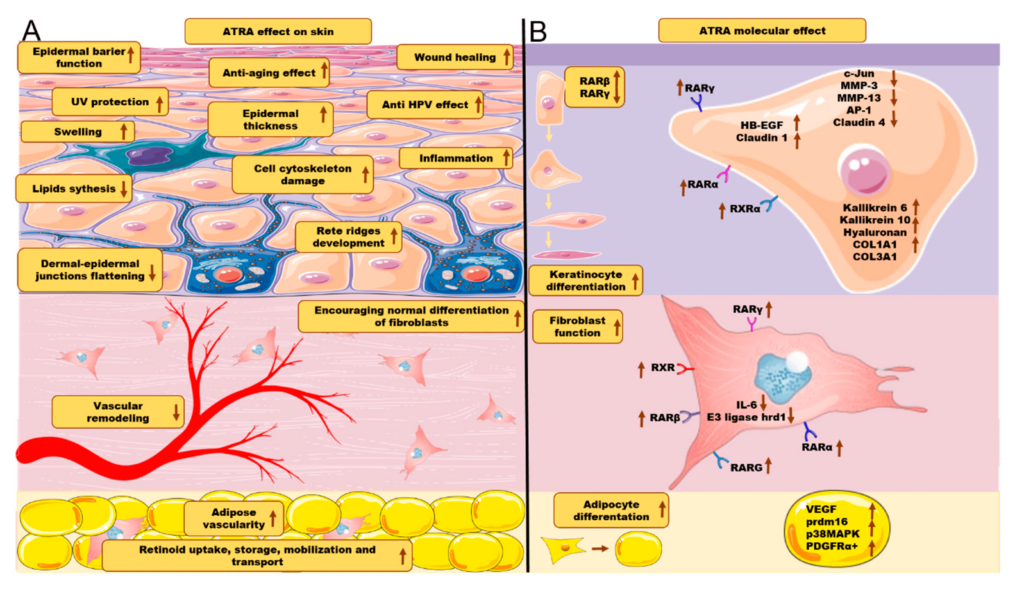Vitamin A and the skin. “Pleiotropic” is a word worth remembering.
Pleiotropic: producing more than one effect.
Does it matter that an ingredient you use on your skin displays pleiotropism? Yes, of course. It means that you can expect more than one desired (advertised!) effect; you have to be observant and make sure that the ingredient doesn’t have a side effect that you don’t want.
The mechanisms of pleiotropism vary. Pleiotropy describes the genetic effect of a single gene on multiple phenotypic traits. The underlying mechanism is genes that code for a product that is either used by various cells or has a cascade-like signaling function that affects various targets. Retinoic acid exerts its pleiotropic effects primarily by controlling the expression of over 500 genes through binding to and activating retinoic acid receptors (RAR) and retinoid X receptors (RXR), both of which are members of the nuclear hormone receptor family.

Figure. (A) ATRA(all-trans-retinoic acid ) effect on skin layers and skin cells. (B) ATRA molecular effects. Arrows directed upwards represent either increase or upregulation. Arrows directed downwards represent either decrease or downregulation. From Szymański, Ł et al. (2020)
Some people (including me) may get confused by the effects of retinoids on metabolism. For example, the association between dietary vitamin A intake and obesity in humans is difficult to study, but several studies employing mice have examined this relationship. In short, it’s complicated. Supplementation of obese rats with high levels of dietary vitamin A led to significant weight loss compared to a control group receiving lower levels of dietary vitamin A. A similar supplementation regimen in lean mice had no effect. In contrast, short-term supplementation with retinoic acid resulted in weight loss, decreased adiposity, and increased insulin sensitivity in several lean and/or obese mouse models. A diet deficient in vitamin A (no detectable vitamin A levels) led to increased adiposity in mice.
The complicated (pleiotropic!) effects may lead some to worry about the effect of topical retinoids on subcutaneous fat. Why? Losing subcutaneous fat makes humans look older. However, if there are any effects, they are subsumed by the benefits of retinoids on the skin itself.
Long-term use (4 years) of tretinoin emollient cream in 27 patients treated with either 0.05% or 0.01% of tretinoin for the first 18 months, followed by 15-month treatment with 0.01% tretinoin and finally 19-month daily treatment with either 0.025% or 0.05% tretinoin. Histological studies indicated that the stratum corneum became compact in the first 3 to 6 months whereas it returned to normal (basket weave pattern) in 12–24 months and remained normal until the end of the therapy. Granular layer thickness and epidermal thickness were increased in the first 3–6 months, returned to normal in 12–24 months, and remained normal until cessation of the therapy. Epidermal mucin continued to increase and melanin continued to decrease throughout tretinoin treatment. The changes in these two components correlated with the observed clinical changes.
Take-home lesson: use your vitamin A cream for acne and anti-age without worrying about subcutaneous fat. Still, you have to be vigilant: if you don’t like what it does to your skin. You are the one that matters.
Hannah
References
Balmer J.E., Blomhoff R. (2002) Gene expression regulation by retinoic acid. J. Lipid Res. 2002;43:1773–1808
Bhawan J, Olsen E, Lufrano L, et al. (1996) Histologic evaluation of the long-term effects of tretinoin on photodamaged skin. J Dermatol Sci. 11:177–82.
Frey SK, Vogel S. (2011) Vitamin A metabolism and adipose tissue biology. Nutrients. 3:27-39. doi: 10.3390/nu3010027. Epub 2011 Jan 6. PMID: 22254074; PMCID: PMC3257733.
Szymański, Ł.; Skopek, R.; Palusińska, M.; Schenk, T.; Stengel, S.; Lewicki, S.; Kraj, L.; Kamiński, P.; Zelent, A. Retinoic Acid and Its Derivatives in Skin. Cells 2020, 9, 2660. https://doi.org/10.3390/cells9122660
Wang, B., Fu, X., Liang, X. et al. (2017) Retinoic acid induces white adipose tissue browning by increasing adipose vascularity and inducing beige adipogenesis of PDGFRα+ adipose progenitors. Cell Discov 3, 17036. https://doi.org/10.1038/celldisc.2017.36
Zasada M, Budzisz E. (2019) Retinoids: active molecules influencing skin structure formation in cosmetic and dermatological treatments. Postepy Dermatol Alergol. 2019 Aug;36(4):392-397. doi: 10.5114/ada.2019.87443. Epub Aug 30. PMID: 31616211; PMCID: PMC6791161.
Ziouzenkova O., Plutzky J. (2008) Retinoid metabolism and nuclear receptor responses: New insights into coordinated regulation of the PPAR-RXR complex. FEBS Lett. ;582:32–38.
